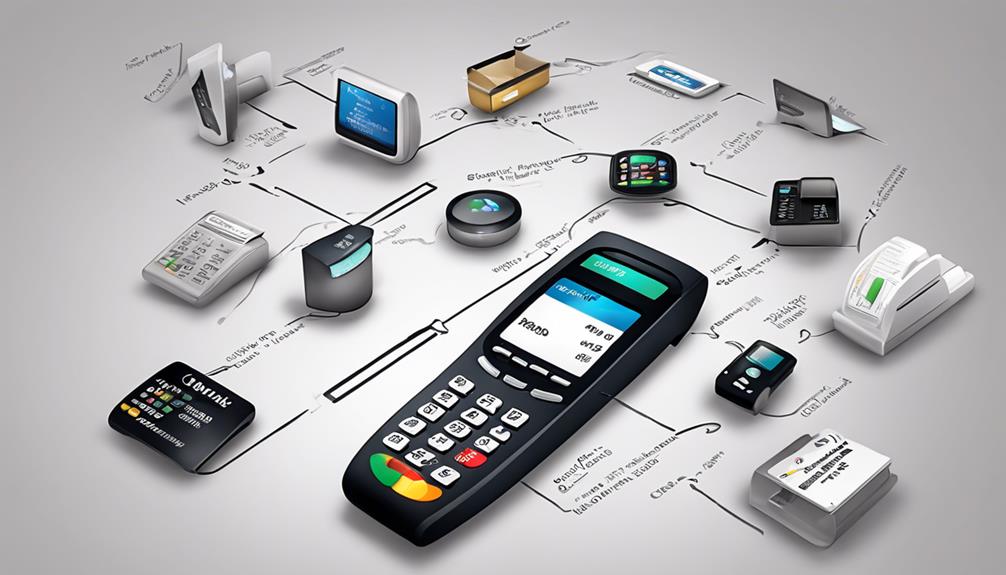Payment processors protect you from fraud and chargebacks by using advanced security tools like encryption, machine learning, and multi-layered authentication. They analyze transactions in real time to spot suspicious activity, verify identities with additional checks, and automatically block risky transactions. They also stay updated with emerging threats to adapt defenses quickly. For seamless, secure online shopping, they combine these methods seamlessly behind the scenes—stay with us to discover how each layer keeps your payments safe.
Key Takeaways
- Implement advanced cryptography protocols to secure transaction data and prevent unauthorized access.
- Use machine learning algorithms to analyze transactions in real time and detect suspicious activity.
- Apply multi-layered authentication methods, such as 3D Secure and one-time passwords, for added security.
- Regularly update security protocols and automate threat responses to address emerging fraud tactics quickly.
- Combine cryptography, machine learning, and authentication to create a comprehensive fraud prevention system.

In today’s digital economy, payment processors play a crucial role in ensuring secure and smooth transactions. They’re the invisible guardians working behind the scenes to protect your financial information from fraudsters and to minimize chargebacks. When you make a purchase online, you might not realize the complex systems at work that keep your data safe. Payment processors utilize advanced cryptography protocols to encrypt sensitive information, making it nearly impossible for hackers to intercept and misuse your card details. These cryptography protocols are the backbone of secure communication, ensuring that your transaction data remains confidential during transmission.
Beyond encryption, payment processors leverage machine learning algorithms to detect suspicious activity in real time. These algorithms analyze patterns within transaction data—such as unusually high purchase amounts, rapid successive transactions, or transactions from unfamiliar locations—and flag potential fraud. Machine learning models improve continually as they process more data, becoming more adept at identifying evolving fraud tactics. This proactive approach helps prevent fraudulent charges before they even reach your account, reducing the risk of financial loss and the inconvenience of chargebacks. Additionally, they often incorporate fraud detection tools that are specifically designed to identify emerging threats based on current trends.
Most payment processors also implement multi-layered authentication measures, like 3D Secure, to verify your identity during transactions. These additional steps add a layer of security, making it harder for unauthorized users to complete purchases on your behalf. If a transaction seems suspicious, the system can automatically trigger additional verification, such as a one-time password sent to your phone, further blocking fraudsters. This layered security approach, combined with cryptography and machine learning, creates a robust barrier against fraud attacks.
Furthermore, payment processors are constantly updating their security protocols and employing sophisticated fraud detection tools. They monitor vast amounts of transaction data across millions of users, enabling them to identify trends and adapt quickly. When a potential threat is detected, they can automatically block the transaction or request further verification, preventing fraudulent charges from being processed. This automation not only protects your finances but also reduces false positives, ensuring legitimate transactions aren’t unnecessarily declined.
In essence, payment processors act as your digital security team, combining cryptography protocols, machine learning, and layered authentication to fight fraud and chargebacks. Their goal is to make online shopping safe and seamless, so you can focus on your purchases without worry. As technology advances, these systems become even more sophisticated, providing stronger defenses against increasingly clever fraud schemes. You benefit from these innovations every time you shop online, knowing your financial information is protected by cutting-edge security measures designed to keep fraud at bay.
Frequently Asked Questions
How Do Payment Processors Detect Suspicious Transactions in Real-Time?
You rely on payment processors to detect suspicious transactions in real-time through advanced transaction monitoring. They use machine learning algorithms that analyze patterns, flag anomalies, and assess risk factors instantly. These algorithms continuously learn from new data, improving detection accuracy. When suspicious activity is detected, they alert you or block the transaction, helping prevent fraud and chargebacks before they happen, keeping your business secure.
Can Merchants Customize Fraud Prevention Settings With Their Payment Processor?
Yes, you can customize fraud prevention settings with your payment processor to suit your merchant control preferences. Many processors allow you to set rules, filter transactions, and enable additional security measures. By tailoring these settings, you enhance fraud prevention, reduce false positives, and create a more secure checkout experience for your customers. Take advantage of these options to better manage risks and protect your business from potential fraud.
What Are the Common Signs of a Fraudulent Chargeback?
A stitch in time saves nine, so spot fraudulent chargebacks early. Common signs include unfamiliar chargeback reasons like “unauthorized transaction,” inconsistent customer details, or suspicious purchase patterns. Use fraud detection tools to identify unusual activity. Look out for sudden spikes in chargebacks, mismatched IP addresses, and multiple disputes from the same customer. Recognizing these signs helps you act swiftly and reduce losses, keeping your business secure.
How Do Payment Processors Handle False Fraud Claims?
Payment processors handle false fraud claims through robust chargeback management. They carefully review each claim, using transaction data and customer communication to identify inaccuracies. When you report a false fraud claim, they contest it with evidence, like proof of delivery or transaction records. This proactive approach helps minimize financial losses and protect your reputation, ensuring only legitimate disputes are upheld while false claims are dismissed efficiently.
Are There Specific Industries More Vulnerable to Chargebacks?
Certain high-risk sectors, like travel, digital goods, and subscription services, are more vulnerable to chargebacks, with some experiencing rates over 1%. These industries face unique vulnerabilities due to buyer disputes, fraud, or dissatisfaction. You should be aware that industry vulnerabilities vary, and high-risk sectors often encounter stricter scrutiny. Staying proactive with fraud prevention and clear communication helps reduce chargeback risks, keeping your business safer and more profitable in these vulnerable sectors.
Conclusion
By leveraging advanced fraud detection tools, real-time monitoring, and proactive chargeback management, payment processors stand as your first line of defense. They analyze, act, and adapt to emerging threats, ensuring your transactions are secure. They prevent fraud, minimize chargebacks, and protect your reputation. In doing so, they empower your business to grow confidently, to operate smoothly, and to succeed consistently. With their support, you can focus on what truly matters—serving your customers and expanding your brand.









